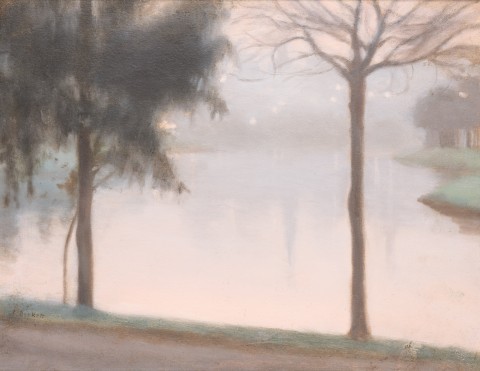VIEW ACROSS THE YARRA, c. 1931
CLARICE BECKETT
oil on pulpboard
34.5 x 45.5 cm
signed lower left: C. Beckett
Malvern Fine Art Gallery, Melbourne,
Mrs Phyllis McBean, Melbourne, acquired from the above in 1972
Thence by descent,
Private collection, Sydney
Across the Yarra, c.1931, oil on cardboard, 31.6 x 45.0 cm, in the collection of the National Gallery of Victoria
There have been a number of significant artists who have been mesmerised by the effects of fog and light, including such names as J. M. W. Turner, James Whistler and Claude Monet. Misty paintings had become so popular in the late nineteenth century that Oscar Wilde was moved to write: ‘There may have been fogs for centuries ... (b)ut no one saw them. They did not exist until art had invented them.’1 The soft-focus photography of Pictorialism also found inspiration here, and two of this country’s finest exponents, Pegg Clarke and John Kauffmann, were prominent in Victoria in the interwar years. There is little doubt that Clarice Beckett was aware of these aesthetic precedents, and through the 1920s and 1930s, she also painted countless views of the city of Melbourne and its bayside suburbs enveloped in the silken haze of fog.
It is perhaps not surprising that the Wurrundjeri people’s name for the Yarra River was ‘birrarung’, meaning ‘place of mist and shadows.’ By day, its waters are brown from the suspended sediment of upriver soils but once night approaches, its mystery is enhanced as reflected lights begin to animate the surface. Beckett painted View across the Yarra, c.1931, from a position adjacent to where Deborah Halpern’s brightly coloured sculpture Angel now stands. In spite of her alliance to the group of artists gathered around the controversial artist-theorist Max Meldrum, Beckett was essentially a solitary figure due to the demands of a home life centred on the care of her aging parents. Given this handicap, the number of city views in her oeuvre are evidence that she still took the most of her scant opportunities to visit the city and paint. Travelling by train or tram, with hand-made painting trolley in tow, she would walk short distances from their terminus before spotting an inspiring location. The site for View across the Yarra, for example, is less than ten minutes walk from Flinders Street station, and Beckett arrived just as the sun was beginning to set. Although the city itself is already lost in the haze, the reflections in the water reveal the twin spires of St. Paul’s Cathedral and Melbourne’s new secular temple, the T&G Building, erected in 1928. This painting is almost identical to Across the Yarra, c.1931, now in the collection of the National Gallery of Victoria; and it is plausible that both may have been painted on the same evening, with View across the Yarra being the first due to the prominence of the pink caused by the setting sun.
Beckett exhibited regularly but struggled to find financial or critical success, even though her talent was celebrated by Meldrum who wrote that she created work ‘of which any nation could be proud.’2 She was also was admired by the famed Heidelberg School artist Tom Roberts, who painted a small sunrise inspired by her work.3 Following Beckett’s premature death in 1935, close friend Percy Leason wrote that the funeral occurred on a beautiful July day. ‘It seemed in some way like Clarice herself, gentle and kindly. ... In the foreground things were clear and vivid; a half mile away, everything was silvery. It was the kind of day that Clarice had loved and painted so well.’4
1. Oscar Wilde, ‘The Decay of Lying’, 1889. See: https://www.sscnet.ucla.edu/comm/steen/cogweb/Abstracts/Wilde_1889.html Viewed 25 March 2021
2. Max Meldrum, cited in: ‘Work of Clarice Beckett’, The Age, 5 May 1936, p.9
3. Tom Roberts, Sunrise, Tasmania, 1924. Collection: Art Gallery of South Australia. See: Lock-Wier, T., Misty Moderns: Australian tonalists 1915-1950, Art Gallery of South Australia, Adelaide, 2008, p.18
4. Percy Leason, 1935 cited in: Tasca, M., Percy Leason: an artist’s life, Melbourne: Thames and Hudson, 2016, p.161
ANDREW GAYNOR
